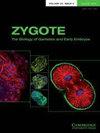Comparative analysis of calcium-sensing receptor (CaSR) expression and function in normal and abnormal human sperm and spermatogenic cells
IF 1.4
4区 生物学
Q4 CELL BIOLOGY
引用次数: 0
Abstract
Summary The calcium-sensing receptor (CaSR) is a critical mediator of calcium homeostasis in various tissues. Its role in human reproduction, especially in sperm function and male fertility, remains not fully elucidated. This study investigates the expression patterns of CaSR in normal and abnormal sperm and spermatogenic cells and evaluates its potential effect on sperm motility and morphology. Using immunohistochemistry (IHC), quantitative PCR (qPCR), we assessed the expression levels of CaSR in normal sperm, spermatogonia, and cases of asthenozoospermia, oligozoospermia, and teratozoospermia.正常和异常人类精子及生精细胞中钙感应受体(CaSR)表达和功能的比较分析
摘要 钙感应受体(CaSR)是各种组织中钙平衡的关键介质。它在人类生殖,尤其是精子功能和男性生育能力中的作用仍未完全阐明。本研究调查了 CaSR 在正常和异常精子及生精细胞中的表达模式,并评估了其对精子活力和形态的潜在影响。通过免疫组化(IHC)和定量 PCR(qPCR)技术,我们评估了 CaSR 在正常精子、精原细胞以及无精子症、少精子症和畸形精子症病例中的表达水平。我们进行了体外功能测试,以分析在不同条件下(包括存在特定的 CaSR 激动剂和拮抗剂),CaSR 调节对精子活力的影响。我们的研究发现,与异常精子样本相比,正常精子和精原细胞中的CaSR表达模式截然不同,尤其是在无精子症、少精子症和畸形精子症中。在这些异常样本中,CaSR 的表达明显减少,这凸显了它在正常精子功能中的重要性。功能测试进一步阐明了 CaSR 在精子运动中的作用。通过特异性激动剂激活 CaSR 可增强精子活力,而通过拮抗剂抑制 CaSR 则会降低精子活力。我们的研究结果表明,CaSR 在维持精子功能方面发挥着重要作用,其表达的变化可能与男性不育有关。这些对精子生理学分子基础的深入了解突出表明,CaSR 是治疗某些形式男性不育症的潜在治疗靶点。
本文章由计算机程序翻译,如有差异,请以英文原文为准。
求助全文
约1分钟内获得全文
求助全文
来源期刊

Zygote
生物-发育生物学
CiteScore
1.70
自引率
5.90%
发文量
117
审稿时长
6-12 weeks
期刊介绍:
An international journal dedicated to the rapid publication of original research in early embryology, Zygote covers interdisciplinary studies on gametogenesis through fertilization to gastrulation in animals and humans. The scope has been expanded to include clinical papers, molecular and developmental genetics. The editors will favour work describing fundamental processes in the cellular and molecular mechanisms of animal development, and, in particular, the identification of unifying principles in biology. Nonetheless, new technologies, review articles, debates and letters will become a prominent feature.
 求助内容:
求助内容: 应助结果提醒方式:
应助结果提醒方式:


